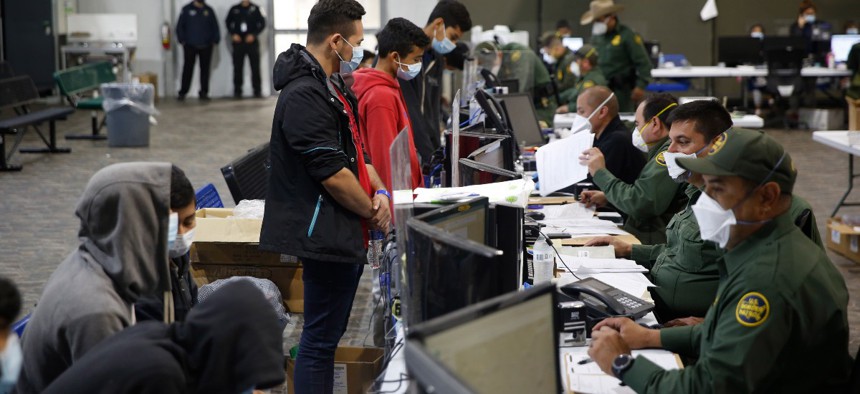CBP Built and Deployed an In-House Electronic Health Record System in Under 2 Years

Migrants are processed at the intake area in the Department of Homeland Security holding facility run by the Customs and Border Protection on March 30, 2021 in Donna, Texas. Dario Lopez-Mills - Pool/Getty Images
Medical service contractors working for the Customs and Border Protection are using an agency app to record migrants’ medical information instead of just writing it down.
Two years after a member of Congress witnessed Customs and Border Protection personnel recording vital medical information on migrant detainees with pen and paper, the agency says it has “fully implemented” an in-house electronic health records system.
While other agencies like the Defense Department and Veterans Affairs Department have purchased and customized commercial EHR software, CBP opted to contract a fully customized tool built into a pre-existing app, called the Web Emergency Operations Center, or WebEOC.
The multipurpose app is used for “a variety of purposes across the CBP enterprise, including incident management, event tracking, workforce emergency notifications, facility and asset management during disasters, and incident simulations and exercise,” according to a privacy impact assessment for the app.
“Due to its customizable event tracking functionality, CBP also uses WebEOC as the intake point for CBP electronic medical records and individual health assessments of individuals in CBP custody,” the document states.
A CBP spokesperson clarified that the system is only used to collect information on people taken into custody for attempting to cross the border illegally—whether crossing between ports of entry, trying to enter the U.S. with fraudulent documents, carrying contraband or the like. U.S. citizens and others crossing legally would not have their medical information entered into the system.
Read More: An Inside Look at All the Data CBP Collects About Everyone Crossing U.S. Borders
The app is used by medical services contractors—third-party providers who do medical assessments as needed for migrants taken into custody by CBP. The contractors use CBP-furnished laptops and desktop computers to access WebEOC through a web portal connected to the CBP-owned and operated National Data Center.
As detainees are processed and medically assessed, the information is entered into the app and linked to ID wristbands as part of the agency’s Amenities, Property and Identification Program, or APIP, ensuring important medical data moves along with detainees if they are transferred to other facilities.
The information is also linked to the Unified Immigration Portal “to import subject biographic information and link a subject’s medical information with an enforcement event,” according to the privacy assessment.
WebEOC also includes an Infectious Disease Community Impact Tracking board that shows rates of infectious disease transmission across the country using anonymized public data sources. According to the privacy assessment, only public data sources are used for that tracking board, and it is not currently integrated with the Electronic Medical Records tool.
“What we hope to do going forward is expand on that even further with various apps and capabilities for additional information sharing and privacy that will make this an even more valuable tool,” CBP Commissioner Chris Magnus said during a May hearing on CBP’s 2023 budget request.
CBP garnered initial funding in 2020 to build the medical records system and integrate it with WebEOC. The agency began initial deployments that November, with staggered deployments through June 2021.
Rep. Lauren Underwood, D-Ill., a registered nurse, has been pushing CBP to institute an EHR since visiting the southern border in 2019.
“Continuity of care is always a challenge but even more so for migrants who may be transferred from one federal agency to another,” she said during the May hearing, adding that during the 2019 visit, “I saw medical records being kept with pen and paper, if at all.”
Since that time, CBP has been working on an in-house electronic health record system that has thus far been rolled out at all border sites where medical services contractors are deployed.
“This system—the Electronic Medical Record—has now been fully deployed” at 75 field offices along the southern border, CBP Commissioner Chris Magnus said at the hearing. “My understanding is that it is working well.”
A CBP spokesperson said the EHR was considered “fully implemented” once it was made available to all medical service providers working for the agency, and only after ensuring it had “all basic functionality that matched what was being utilized in the field via paper documents.”
“Once the CBP [electronic medical record] reached this goal—Digital Whiteboard, Medical Assessments, Medical Encounters and CBP Medical Summary Form (CBP 2501)—and had all CBP facilities with contract medical personnel onsite using the CBP EMR, it was considered ‘fully implemented,’” they said.
The spokesperson said CBP conducted on-site training before each deployment and continues to offer virtual trainings twice weekly for new users, as well as existing users who need to brush up on the functionality.
“The program is fully implemented within the various locations,” Magnus said. “But, of course, our plan is to continually evolve it as the technology continues to improve, as we’ve seen in other environments. It will be a continually evolving resource for us.”
One such improvement will be moving the WebEOC app to a cloud-based infrastructure, which the spokesperson said is in the works, with “plans to move to the cloud within the next 12 to 24 months.”
The agency is also determining which other federal agencies—including DHS components like Immigration and Customs Enforcement—will have access to the data collected through the EHR.
“CBP is working with federal partners to establish information-sharing arrangements as appropriate,” the spokesperson said, but declined to offer details on which agencies are part of those conversations.






